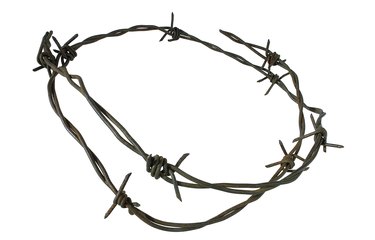Things You'll Need
Rebar rod, 28 inches
Hack saw with metal cutting blade
Stovepipe wire, 10 gauge, 21 foot roll
Work gloves
Barbed wire from farmer, 16 feet
Pliers
Wire cutters, heavy duty

The words "barbed wire" bring to mind all sorts of uncomfortable associations--sharp and thorny, dangerous and prickly. The word "artistic" is not one of them. But old barbed wire, carefully harvested from fields and old barns, has become the material of choice for some artists and sculptors. For them, barbed wire is appealing because it offers different associations--rustic and evocative, homespun and folk artish. Barbed wire art can add a unique accent of genuine charm and beauty to your interior decor or garden space.
Rustic Barbed Wire Cross
Step 1
Cut the rebar rod with a hack saw into two sizes--12 inch and 16 inch.
Video of the Day
Step 2
Form a cross with the two pieces of rebar and wire them together tightly in the center where they cross with the 10 gauge stovepipe wire. Wrap the wire in one direction, cut it and tuck it underneath other wire. Repeat this process wiring in the other direction. This is the structural support for the cross.
Step 3
Tightly wrap a layer of stovepipe wire over the cross. Bend the last strand of wire and tuck it under to keep from sight. Repeat with a second layer, but more loosely wrapped. This forms the wire base the barbed wire will be applied to.
Step 4
Put on gloves and cut a 4 foot long section of the barbed wire with the wire cutters. Take the pliers and fold and tuck one end of the barbed wire into one of the loose ends (at one of the tips) and begin wrapping the wire around the rebar support. Wrap the wire loosely while creating small artistic loops. When you reach the other side of the cross, fold and tuck the end of barbed wire underneath the wrapped barbed wire so that it is out of sight. Repeat this process of wrapping wire around the rebar with the rest of the cross until finished.
Step 5
Turn the finished barbed wire cross over and lay it on the work surface. Cut a 12 inch strip of stovepipe wire and twist it in half into a loop shape. Insert the open ends of the loop through the barbed wire near the center section of the cross and and loop them back out again. Twist the ends together securely to form a strong wall hanging looped hook.
Tip
Rebar is a steel rod that can be purchased at home building centers. It is generally used for reinforcement when working with concrete.
If the old barbed wire has imperfections or knots in it, don't cut them out. They provide nice visual contrast to the more repetitive wrapped wire.
Some wire forms that are used to make Christmas wreaths or animal lights may also work as supports for barbed wire art as long as they are solid and well made.
Study decorative antique metal crosses in graveyards to see the beautiful variety of metalwork and shapes that can be used when making barbed wire crosses.
To "mute down" the points of the barbed wire, use a torch to soften the metal and pound them down to dull tips on an anvil.
Warning
Do not allow children near sculptures made with barbed wire. Display your barbed wire up high beyond their reach.
Be sure your tetanus shot is up to date before working with barbed wire to prevent tetanus poisoning resulting from being cut deeply by rusted wire.
Video of the Day